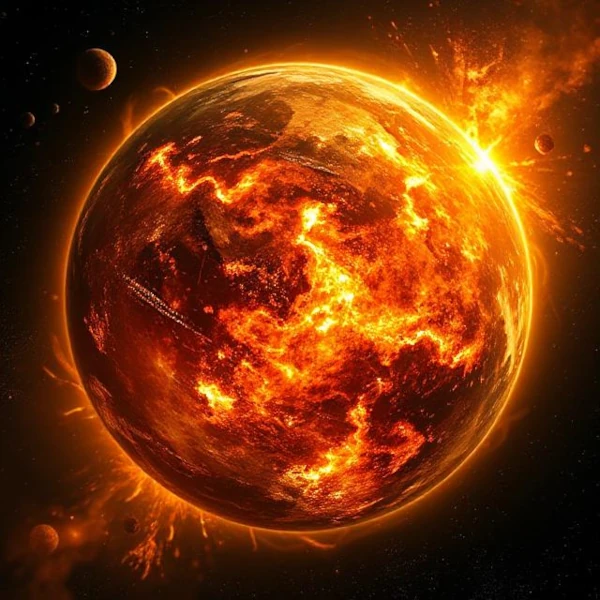
About 4.56 billion years ago, the young Earth had just formed from a collapsing protoplanetary disk around the Sun. At that time, collisions between planetesimals released colossal energy, transforming the Earth's surface into a magma ocean hundreds of kilometers deep. Average temperatures exceeded 2000 K. This global molten state allowed gravitational differentiation: heavy elements like iron and nickel sank toward the core, while lighter silicates formed the primitive mantle.
Note:
The kelvin (K) is the SI base unit of thermodynamic temperature. It corresponds to the fraction \(1/273{,}16\) of the thermodynamic temperature of the triple point of water. Thus, 0 K represents absolute zero, the temperature at which all thermal motion theoretically ceases. To convert to degrees Celsius: \(T(°C) = T(K) - 273{,}15\).
During the magma ocean phase, surface temperatures reached 2000–2500 K, and the core possibly 7000–8000 K.
Today, the core temperature is estimated at 5000–6500 K. This thermal decrease barely affects hydrostatic pressure, which depends mainly on mass and density distribution, but significantly changes the physical state of internal layers.
Cooling mainly occurred in the outer layers, while the inner core and outer core remain partially liquid/solid. Residual heat persists due to multiple physical contributions: accretional heat, latent heat released during iron crystallization, and radiogenic heat from unstable isotope decay (e.g., U, K, Th).
These thermal processes feed mantle convection and maintain a significant heat flux toward the surface. Thus, although the planet has emerged from global melting, it remains thermally active and continues to evolve on geological timescales.
Progressive cooling began once major impacts ceased, notably after the giant collision with Theia, a Mars-sized body, around 4.47 billion years ago. This impact created a new thermal reservoir and the Moon. When surface temperatures dropped below the silicate solidification point (~1600 K), crystals began forming in the magma sea. These crystals, mainly olivine and pyroxene, formed the first unstable solid crust.
According to geochemist Victor Moritz Goldschmidt (1888-1947), element separation between the metallic core and silicate mantle determined the Earth's present chemical composition. The stratified structure, with an Fe-Ni-rich core and a Mg-Si silicate-dominated mantle, is a direct result of this infernal phase.
Intense degassing of magma released huge amounts of CO₂, water vapor, and sulfur, forming a thick, toxic atmosphere. Atmospheric pressure exceeded several hundred bars and the surface was subject to an extreme greenhouse effect. When temperatures eventually dropped below ~647 K (critical point of water), water vapor could separate into liquid and vapor; heavy rainfall became possible. Torrential rains lasting millions of years eroded the first basalts and helped form the oceanic protosphere.
Internal heat dissipated via radiation and mantle convection. However, direct radiation to the icy space was strongly limited. The primitive atmosphere, thick and rich in water vapor, CO₂, and volcanic particles, absorbed most infrared radiation emitted by the molten surface. Early Earth behaved as a gigantic greenhouse oven: heat remained trapped in atmospheric layers, greatly slowing global cooling.
| Time (Ga) | Main event | Estimated temperature (K) | Geological state |
|---|---|---|---|
| 4.56 | Accretion and global melting | ≈ 2500 | Full magma ocean |
| 4.47 | Theia impact, Moon formation | ≈ 2200 | Partial mantle remelting |
| 4.40 | First basaltic crust solidification | ≈ 1600 | Formation of a superficial solid crust |
| 4.30 | Water vapor condensation | ≈ 800 | Torrential rains and primary erosion |
| 4.10 | Beginning of mantle thermal stabilization | ≈ 600 | Gradual cooling, mantle convection still active |
| 4.00 | Mantle stabilization and first rocks | ≈ 500 | Beginning of primitive tectonics |
| 3.90 | Cooling sufficient for stable oceans | ≈ 300–400 | Permanent liquid oceans and stabilized crust |
| 3.80 | Formation of first sediments | ≈ 300 | Sedimentary deposits in oceans, start of geochemical cycles |
| 3.70 | Possible emergence of primitive life | ≈ 300 | Favorable chemical conditions in stable oceans |
| 3.50 | Global tectonic stabilization | ≈ 290–300 | Formation of first continental platforms, active hydrological cycle |
| 3.50 | Confirmed appearance of first life forms | ≈ 300 | Stable oceans, first microbial life (stromatolites) |
Source: Nature Geoscience, Science Advances.
Early Earth's mineral hell shaped the planet's fundamental properties: density, chemical composition, and internal dynamics. This fiery phase enabled mantle genesis, formation of the magnetic core, and release of precursor gases for the atmosphere. Paradoxically, this infernal episode made later stable conditions and, eventually, life possible.